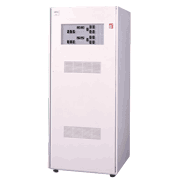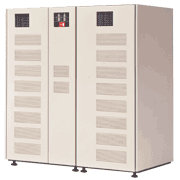The F6495 array disk unit*1 was a highly reliable storage system designed for continuous 24/7 operation. It featured RAID technology (RAID 0+1 (equivalent to 1+0)) — known as cluster mirroring, data redundancy using cache memory, component redundancy, and live maintenance and servicing. Fujitsu began shipping the unit in August 1997 as the successor to the F6493.
- *1. The term “array disk” was used at the time, but eventually “disk array” would become the standard term.
There were two F6495 lines: the F6495GA, F6495HA, and F6495KA contained disk clusters and controllers while the F6495GB, F6495HB, and F6495KB only contained disk clusters. The three models supported three different logical volume capacities — 1,260 MB, 1,890 MB, and 2,835 MB.
The F6495 array disk units had the following features:
- Cluster mirroring: a function in which data from the host server (a mainframe or open server) was written simultaneously to two independent and redundant disk clusters. If a disk in one cluster fails, operation can continue without affecting services by using the data recorded in the other disk cluster. And with hot-spare disks, the unit could recover automatically from up to six failed disks in one cluster.
- Component multiplexing and live maintenance: The F6495 used a multiplexed configuration of components along the device path, including cache memory, fans, and power supplies, thereby preventing hardware failures from affecting services. Additionally, nearly all components were hot swappable for easier maintenance.
- Large-capacity hard drives: The F6495 used high-density 3.5-inch hard drives (9 GB, 7200 rpm), developed with the latest technology, improved the data transfer performance between the controllers and the disks, and increased operation stability.
- Connectivity with open servers: The F6495 improved connectivity with open servers by supporting the SCSI interface, the standard interface among open servers. This could lead to more effective data utilization because data residing on core servers (mainframes) could be deployed on information systems using open servers.
- Lower running costs: The F6495 used less space and energy and emitted less heat by using high-density hard drives and high-density mounting technology. The F6495 in a 64-volume configuration used 47 percent of the space and 38 percent of the power of the previous F6429H model.
| F6495G | F6495H | F6495K | ||
|---|---|---|---|---|
| Initial shipping date | August 1997 | |||
| Storage capacities | Per unit | Basic configuration :10.08 GB Full configuration:322.56 GB |
Basic configuration :15.12 GB Full configuration:484.84 GB |
Basic configuration :17.01 GB Full configuration:714.42 GB |
| Logical volume size | 1,260 MB | 1,890 MB | 2,835 MB | |
| Expansion increment | 5.04 GB | 7.56 GB | 11.34 GB | |
| Track capacity | 47,476 byte | |||
| Configurations | Clusters per unit | 1 — 4pairs | ||
| Logical volumes per unit | 8 — 256 | 6 — 252 | ||
| Drive-controller data transfer speed | 20 MB/s | |||
| Data transfer speed | Electrical channel | 3.0 MB/s,4.5 MB/s | ||
| Optical channels | 6.0 MB/s,9.0 MB/s | |||
| SCSI | 12 MB/s,17 MB/s | |||
| Number of channels | 4, 8, 12, or 16 | |||





